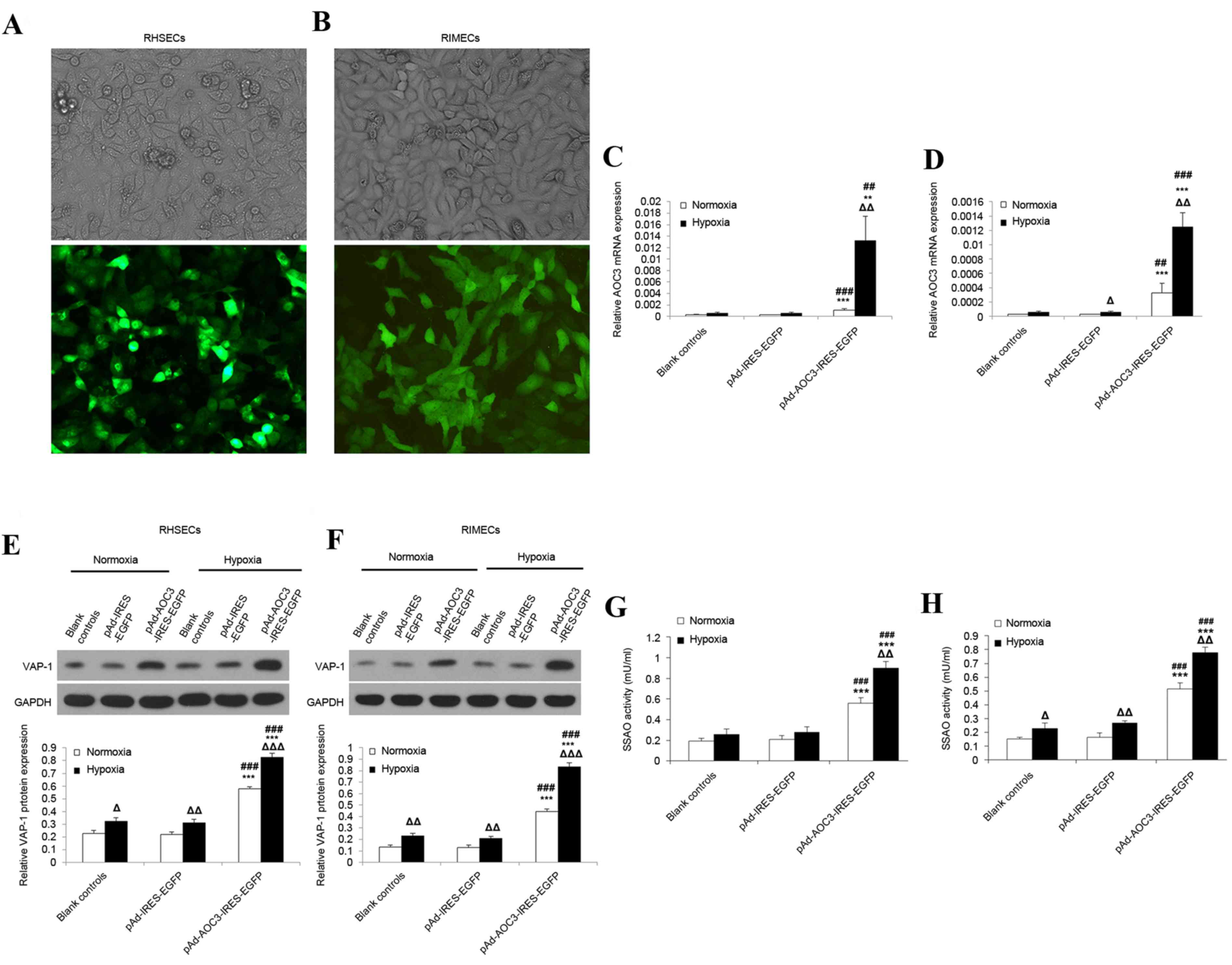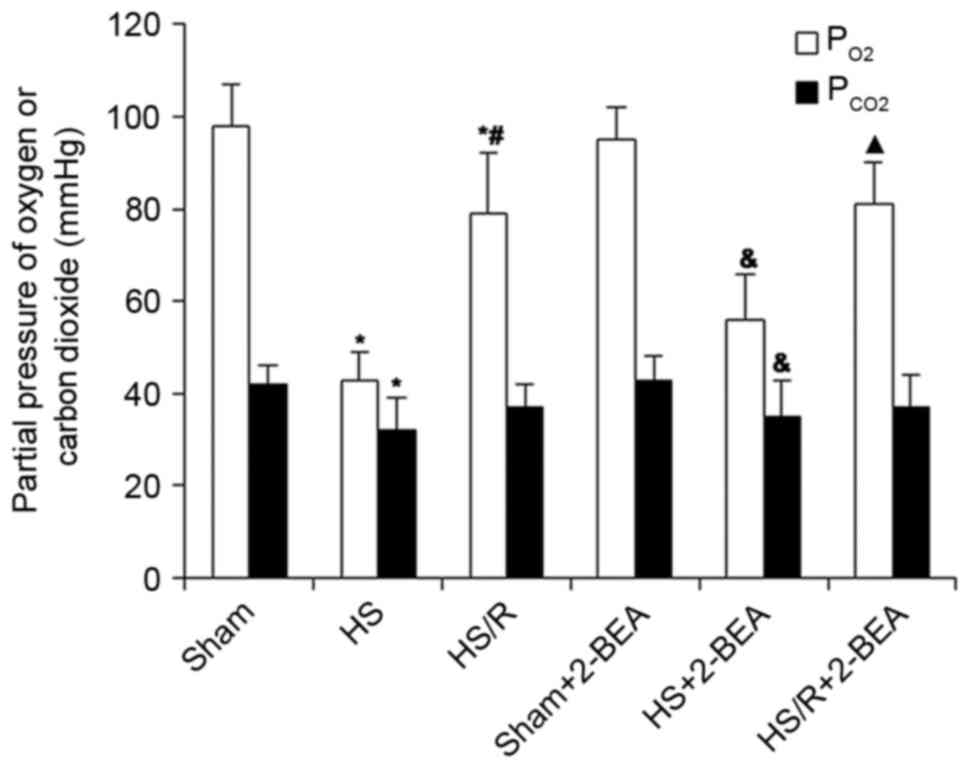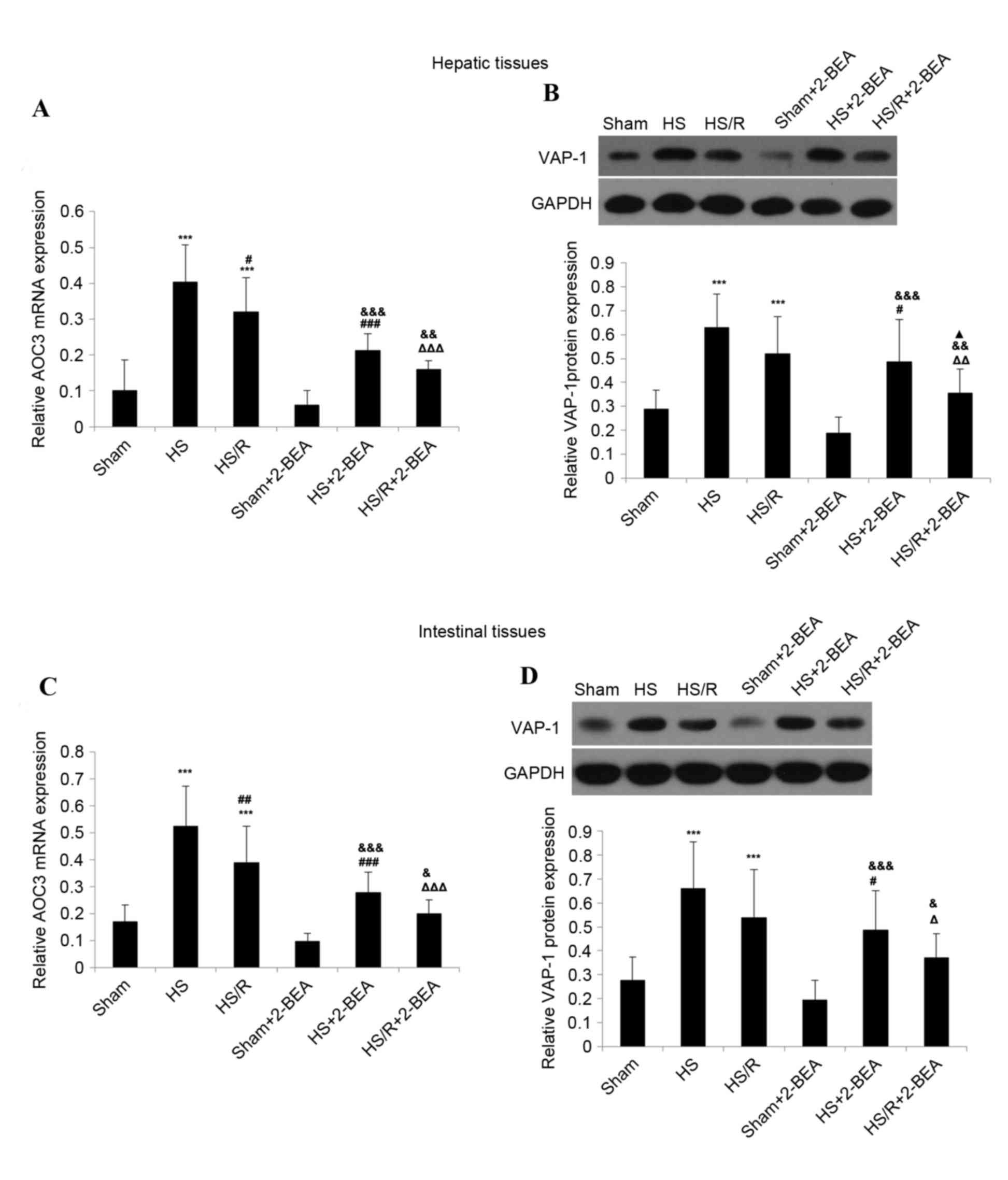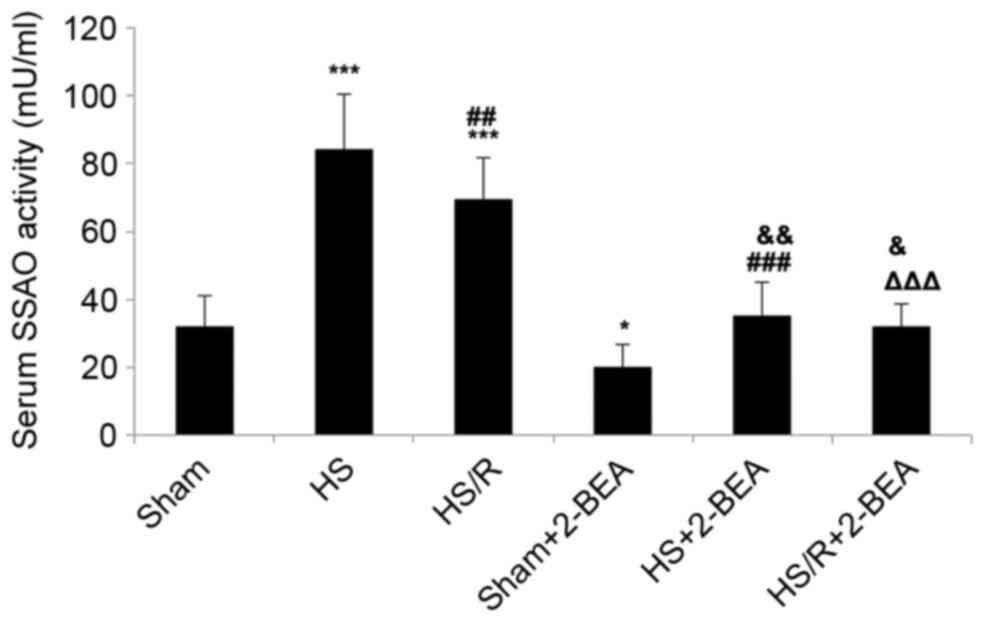|
1
|
Kauvar DS, Lefering R and Wade CE: Impact
of hemorrhage on trauma outcome: An overview of epidemiology,
clinical presentations, and therapeutic considerations. J Trauma.
60 6 Suppl:S3–S11. 2006. View Article : Google Scholar : PubMed/NCBI
|
|
2
|
Rossaint R, Cerny V, Coats TJ, Duranteau
J, Fernández-Mondéjar E, Gordini G, Stahel PF, Hunt BJ, Neugebauer
E and Spahn DR: Key issues in advanced bleeding care in trauma.
Shock. 26:322–331. 2006. View Article : Google Scholar : PubMed/NCBI
|
|
3
|
Angele MK, Schneider CP and Chaudry IH:
Bench-to-bedside review: Latest results in hemorrhagic shock. Crit
Care. 12:2182008. View
Article : Google Scholar : PubMed/NCBI
|
|
4
|
Gann DS and Drucker WR: Hemorrhagic shock.
J Trauma Acute Care Surg. 75:888–895. 2013. View Article : Google Scholar : PubMed/NCBI
|
|
5
|
Karmaniolou II, Theodoraki KA, Orfanos NF,
Kostopanagiotou GG, Smyrniotis VE, Mylonas AI and Arkadopoulos NF:
Resuscitation after hemorrhagic shock: The effect on the liver-a
review of experimental data. J Anesth. 27:447–460. 2013. View Article : Google Scholar : PubMed/NCBI
|
|
6
|
Novosad VL, Richards JL, Phillips NA, King
MA and Clanton TL: Regional susceptibility to stress-induced
intestinal injury in the mouse. Am J Physiol Gastrointest Liver
Physiol. 305:G418–G426. 2013. View Article : Google Scholar : PubMed/NCBI
|
|
7
|
Spahn DR, Cerny V, Coats TJ, Duranteau J,
Fernández-Mondéjar E, Gordini G, Stahel PF, Hunt BJ, Komadina R,
Neugebauer E, et al: Management of bleeding following major trauma:
A European guideline. Crit Care. 11:R172007. View Article : Google Scholar : PubMed/NCBI
|
|
8
|
Smith DJ, Salmi M, Bono P, Hellman J, Leu
T and Jalkanen S: Cloning of vascular adhesion protein 1 reveals a
novel multifunctional adhesion molecule. J Exp Med. 188:17–27.
1998. View Article : Google Scholar : PubMed/NCBI
|
|
9
|
Salmi M, Kalimo K and Jalkanen S:
Induction and function of vascular adhesion protein-1 at sites of
inflammation. J Exp Med. 178:2255–2260. 1993. View Article : Google Scholar : PubMed/NCBI
|
|
10
|
Morris NJ, Ducret A, Aebersold R, Ross SA,
Keller SR and Lienhard GE: Membrane amine oxidase cloning and
identification as a major protein in the adipocyte plasma membrane.
J Biol Chem. 272:9388–9392. 1997. View Article : Google Scholar : PubMed/NCBI
|
|
11
|
Kurkijarvi R, Adams DH, Leino R, Möttönen
T, Jalkanen S and Salmi M: Circulating form of human vascular
adhesion protein-1 (VAP-1): Increased serum levels in inflammatory
liver diseases. J Immunol. 161:1549–1557. 1998.PubMed/NCBI
|
|
12
|
Klinman JP and Mu D: Quinoenzymes in
biology. Annu Rev Biochem. 63:299–344. 1994. View Article : Google Scholar : PubMed/NCBI
|
|
13
|
Lyles GA: Mammalian plasma and
tissue-bound semicarbazide-sensitive amine oxidases: Biochemical,
pharmacological and toxicological aspects. Int J Biochem Cell Biol.
28:259–274. 1996. View Article : Google Scholar : PubMed/NCBI
|
|
14
|
Wilmot CM, Hajdu J, McPherson MJ, Knowles
PF and Phillips SE: Visualization of dioxygen bound to copper
during enzyme catalysis. Science. 286:1724–1728. 1999. View Article : Google Scholar : PubMed/NCBI
|
|
15
|
McNab G, Reeves JL, Salmi M, Hubscher S,
Jalkanen S and Adams DH: Vascular adhesion protein 1 mediates
binding of T cells to human hepatic endothelium. Gastroenterology.
110:522–528. 1996. View Article : Google Scholar : PubMed/NCBI
|
|
16
|
Jaakkola K, Jalkanen S, Kaunismäki K,
Vänttinen E, Saukko P, Alanen K, Kallajoki M, Voipio-Pulkki LM and
Salmi M: Vascular adhesion protein-1, intercellular adhesion
molecule-1 and P-selectin mediate leukocyte binding to ischemic
heart in humans. J Am Coll Cardiol. 36:122–129. 2000. View Article : Google Scholar : PubMed/NCBI
|
|
17
|
Tohka S, Laukkanen M, Jalkanen S and Salmi
M: Vascular adhesion protein 1 (VAP-1) functions as a molecular
brake during granulocyte rolling and mediates recruitment in vivo.
FASEB J. 15:373–382. 2001. View Article : Google Scholar : PubMed/NCBI
|
|
18
|
Lalor PF, Edwards S, McNab G, Salmi M,
Jalkanen S and Adams DH: Vascular adhesion protein-1 mediates
adhesion and transmigration of lymphocytes on human hepatic
endothelial cells. J Immunol. 169:983–992. 2002. View Article : Google Scholar : PubMed/NCBI
|
|
19
|
Koskinen K, Vainio PJ, Smith DJ,
Pihlavisto M, Ylä-Herttuala S, Jalkanen S and Salmi M: Granulocyte
transmigration through the endothelium is regulated by the oxidase
activity of vascular adhesion protein-1 (VAP-1). Blood.
103:3388–3395. 2004. View Article : Google Scholar : PubMed/NCBI
|
|
20
|
Aspinall AI, Curbishley SM, Lalor PF,
Weston CJ, Blahova M, Liaskou E, Adams RM, Holt AP and Adams DH:
CX(3)CR1 and vascular adhesion protein-1-dependent recruitment of
CD16(+) monocytes across human liver sinusoidal endothelium.
Hepatology. 51:2030–2039. 2010. View Article : Google Scholar : PubMed/NCBI
|
|
21
|
Stolen CM, Marttila-Ichihara F, Koskinen
K, Yegutkin GG, Turja R, Bono P, Skurnik M, Hänninen A, Jalkanen S
and Salmi M: Absence of the endothelial oxidase AOC3 leads to
abnormal leukocyte traffic in vivo. Immunity. 22:105–115. 2005.
View Article : Google Scholar : PubMed/NCBI
|
|
22
|
Marttila-Ichihara F, Smith DJ, Stolen C,
Yegutkin GG, Elima K, Mercier N, Kiviranta R, Pihlavisto M,
Alaranta S, Pentikäinen U, et al: Vascular amine oxidases are
needed for leukocyte extravasation into inflamed joints in vivo.
Arthritis Rheum. 54:2852–2862. 2006. View Article : Google Scholar : PubMed/NCBI
|
|
23
|
Salmi M and Jalkanen S: Homing-associated
molecules CD73 and VAP-1 as targets to prevent harmful
inflammations and cancer spread. FEBS Lett. 585:1543–1550. 2011.
View Article : Google Scholar : PubMed/NCBI
|
|
24
|
Weston CJ and Adams DH: Hepatic
consequences of vascular adhesion protein-1 expression. J Neural
Transm (Vienna). 118:1055–1064. 2011. View Article : Google Scholar : PubMed/NCBI
|
|
25
|
Lin MS, Li HY, Wei JN, Lin CH, Smith DJ,
Vainio J, Shih SR, Chen YH, Lin LC, Kao HL, et al: Serum vascular
adhesion protein-1 is higher in subjects with early stages of
chronic kidney disease. Clin Biochem. 41:1362–1367. 2008.
View Article : Google Scholar : PubMed/NCBI
|
|
26
|
Sallisalmi M, Tenhunen J, Yang R, Oksala N
and Pettilä V: Vascular adhesion protein-1 and syndecan-1 in septic
shock. Acta Anaesthesiol Scand. 56:316–322. 2012. View Article : Google Scholar : PubMed/NCBI
|
|
27
|
Martelius T, Salaspuro V, Salmi M,
Krogerus L, Höckerstedt K, Jalkanen S and Lautenschlager I:
Blockade of vascular adhesion protein-1 inhibits lymphocyte
infiltration in rat liver allograft rejection. Am J Pathol.
165:1993–2001. 2004. View Article : Google Scholar : PubMed/NCBI
|
|
28
|
Merinen M, Irjala H, Salmi M, Jaakkola I,
Hänninen A and Jalkanen S: Vascular adhesion protein-1 is involved
in both acute and chronic inflammation in the mouse. Am J Pathol.
166:793–800. 2005. View Article : Google Scholar : PubMed/NCBI
|
|
29
|
Bonder CS, Norman MU, Swain MG, Zbytnuik
LD, Yamanouchi J, Santamaria P, Ajuebor M, Salmi M, Jalkanen S and
Kubes P: Rules of recruitment for Th1 and Th2 lymphocytes in
inflamed liver: A role for alpha-4 integrin and vascular adhesion
protein-1. Immunity. 23:153–163. 2005. View Article : Google Scholar : PubMed/NCBI
|
|
30
|
Salter-Cid LM, Wang E, O'Rourke AM, Miller
A, Gao H, Huang L, Garcia A and Linnik MD: Anti-inflammatory
effects of inhibiting the amine oxidase activity of
semicarbazide-sensitive amine oxidase. J Pharmacol Exp Ther.
315:553–562. 2005. View Article : Google Scholar : PubMed/NCBI
|
|
31
|
Xu HL, Salter-Cid L, Linnik MD, Wang EY,
Paisansathan C and Pelligrino DA: Vascular adhesion protein-1 plays
an important role in postischemic inflammation and neuropathology
in diabetic, estrogen-treated ovariectomized female rats subjected
to transient forebrain ischemia. J Pharmacol Exp Ther. 317:19–29.
2006. View Article : Google Scholar : PubMed/NCBI
|
|
32
|
O'Rourke AM, Wang EY, Miller A, Podar EM,
Scheyhing K, Huang L, Kessler C, Gao H, Ton-Nu HT, Macdonald MT, et
al: Anti-inflammatory effects of LJP 1586
[Z-3-fluoro-2-(4-methoxybenzyl)allylamine hydrochloride], an
amine-based inhibitor of semicarbazide-sensitive amine oxidase
activity. J Pharmacol Exp Ther. 324:867–875. 2008. View Article : Google Scholar : PubMed/NCBI
|
|
33
|
Irjala H, Salmi M, Alanen K, Grénman R and
Jalkanen S: Vascular adhesion protein 1 mediates binding of
immunotherapeutic effector cells to tumor endothelium. J Immunol.
166:6937–6943. 2001. View Article : Google Scholar : PubMed/NCBI
|
|
34
|
Marttila-Ichihara F, Auvinen K, Elima K,
Jalkanen S and Salmi M: Vascular adhesion protein-1 enhances tumor
growth by supporting recruitment of Gr-1+CD11b+ myeloid cells into
tumors. Cancer Res. 69:7875–7883. 2009. View Article : Google Scholar : PubMed/NCBI
|
|
35
|
Yasuda H, Toiyama Y, Ohi M, Mohri Y, Miki
C and Kusunoki M: Serum soluble vascular adhesion protein-1 is a
valuable prognostic marker in gastric cancer. J Surg Oncol.
103:695–699. 2011. View Article : Google Scholar : PubMed/NCBI
|
|
36
|
Airas L, Lindsberg PJ,
Karjalainen-Lindsberg ML, Mononen I, Kotisaari K, Smith DJ and
Jalkanen S: Vascular adhesion protein-1 in human ischaemic stroke.
Neuropathol Appl Neurobiol. 34:394–402. 2008. View Article : Google Scholar : PubMed/NCBI
|
|
37
|
Hernandez-Guillamon M, Garcia-Bonilla L,
Solé M, Sosti V, Parés M, Campos M, Ortega-Aznar A, Domínguez C,
Rubiera M, Ribó M, et al: Plasma VAP-1/SSAO activity predicts
intracranial hemorrhages and adverse neurological outcome after
tissue plasminogen activator treatment in stroke. Stroke.
41:1528–1535. 2010. View Article : Google Scholar : PubMed/NCBI
|
|
38
|
Arvilommi AM, Salmi M and Jalkanen S:
Organ-selective regulation of vascular adhesion protein-1
expression in man. Eur J Immunol. 27:1794–1800. 1997. View Article : Google Scholar : PubMed/NCBI
|
|
39
|
Martelius T, Salmi M, Wu H, Bruggeman C,
Höckerstedt K, Jalkanen S and Lautenschlager I: Induction of
vascular adhesion protein-1 during liver allograft rejection and
concomitant cytomegalovirus infection in rats. Am J Pathol.
157:1229–1237. 2000. View Article : Google Scholar : PubMed/NCBI
|
|
40
|
Galley HF and Webster NR: The
immuno-inflammatory cascade. Br J Anaesth. 77:11–16. 1996.
View Article : Google Scholar : PubMed/NCBI
|
|
41
|
Lamb RE and Goldstein BJ: Modulating an
oxidative-inflammatory cascade: Potential new treatment strategy
for improving glucose metabolism, insulin resistance, and vascular
function. Int J Clin Pract. 62:1087–1095. 2008. View Article : Google Scholar : PubMed/NCBI
|
|
42
|
Xiaojun Y, Cheng Q, Yuxing Z and Zhiqian
H: Microarray analysis of differentially expressed background genes
in rats following hemorrhagic shock. Mol Biol Rep. 39:2045–2053.
2012. View Article : Google Scholar : PubMed/NCBI
|
|
43
|
Solé M and Unzeta M: Vascular cell lines
expressing SSAO/VAP-1: A new experimental tool to study its
involvement in vascular diseases. Biol Cell. 103:543–557. 2011.
View Article : Google Scholar : PubMed/NCBI
|
|
44
|
Sun P, Esteban G, Inokuchi T,
Marco-Contelles J, Weksler BB, Romero IA, Couraud PO, Unzeta M and
Solé M: Protective effect of the multitarget compound DPH-4 on
human SSAO/VAP-1-expressing hCMEC/D3 cells under oxygen-glucose
deprivation conditions: An in vitro experimental model of cerebral
ischaemia. Br J Pharmacol. 172:5390–5402. 2015. View Article : Google Scholar : PubMed/NCBI
|
|
45
|
Salmi M and Jalkanen S: Different forms of
human vascular adhesion protein-1 (VAP-1) in blood vessels in vivo
and in cultured endothelial cells: Implications for
lymphocyte-endothelial cell adhesion models. Eur J Immunol.
25:2803–2812. 1995. View Article : Google Scholar : PubMed/NCBI
|
|
46
|
Johansson EL, Rudin A, Wassén L and
Holmgren J: Distribution of lymphocytes and adhesion molecules in
human cervix and vagina. Immunology. 96:272–277. 1999. View Article : Google Scholar : PubMed/NCBI
|
|
47
|
Livak KJ and Schmittgen TD: Analysis of
relative gene expression data using real-time quantitative PCR and
the 2(−Delta Delta C(T)) Method. Methods. 402–408. 2001. View Article : Google Scholar : PubMed/NCBI
|
|
48
|
Sun P, Solé M and Unzeta M: Involvement of
SSAO/VAP-1 in oxygen-glucose deprivation-mediated damage using the
endothelial hSSAO/VAP-1-expressing cells as experimental model of
cerebral ischemia. Cerebrovasc Dis. 37:171–180. 2014. View Article : Google Scholar : PubMed/NCBI
|
|
49
|
Imtiyaz HZ and Simon MC: Hypoxia-inducible
factors as essential regulators of inflammation. Curr Top Microbiol
Immunol. 345:105–120. 2010.PubMed/NCBI
|
|
50
|
Greer SN, Metcalf JL, Wang Y and Ohh M:
The updated biology of hypoxia-inducible factor. EMBO J.
31:2448–2460. 2012. View Article : Google Scholar : PubMed/NCBI
|
|
51
|
Hernandez-Guillamon M, Solé M, Delgado P,
García-Bonilla L, Giralt D, Boada C, Penalba A, García S, Flores A,
Ribó M, et al: VAP-1/SSAO plasma activity and brain expression in
human hemorrhagic stroke. Cerebrovasc Dis. 33:55–63. 2012.
View Article : Google Scholar : PubMed/NCBI
|
|
52
|
Kinemuchi H, Kobayashi N, Takahashi K,
Takayanagi K, Arai Y, Tadano T, Kisara K and Oreland L: Inhibition
of tissue-bound semicarbazide-sensitive amine oxidase by two
haloamines, 2-bromoethylamine and 3-bromopropylamine. Arch Biochem
Biophys. 385:154–161. 2001. View Article : Google Scholar : PubMed/NCBI
|
|
53
|
Kobayashi N, Takahashi K, Takayanagi K,
Takahashi K, Masuko S, Tadano T, Kisara K and Kinemuchi H:
Molecular characteristics of tissue-bound semicarbazide-sensitive
amine oxidase (SSAO) in guinea pig tissues. Life Sci. 70:1519–1531.
2002. View Article : Google Scholar : PubMed/NCBI
|
|
54
|
Lalor PF, Sun PJ, Weston CJ, Martin-Santos
A, Wakelam MJ and Adams DH: Activation of vascular adhesion
protein-1 on liver endothelium results in an NF-kappaB-dependent
increase in lymphocyte adhesion. Hepatology. 45:465–474. 2007.
View Article : Google Scholar : PubMed/NCBI
|
|
55
|
Lalor PF, Tuncer C, Weston C,
Martin-Santos A, Smith DJ and Adams DH: Vascular adhesion protein-1
as a potential therapeutic target in liver disease. Ann N Y Acad
Sci. 1110:485–496. 2007. View Article : Google Scholar : PubMed/NCBI
|
|
56
|
Xu HL, Garcia M, Testai F, Vetri F,
Barabanova A, Pelligrino DA and Paisansathan C: Pharmacologic
blockade of vascular adhesion protein-1 lessens neurologic
dysfunction in rats subjected to subarachnoid hemorrhage. Brain
Res. 1586:83–89. 2014. View Article : Google Scholar : PubMed/NCBI
|
|
57
|
Xu H, Testai FD, Valyi-Nagy T, N Pavuluri
M, Zhai F, Nanegrungsunk D, Paisansathan C and Pelligrino DA: VAP-1
blockade prevents subarachnoid hemorrhage-associated
cerebrovascular dilating dysfunction via repression of a neutrophil
recruitment-related mechanism. Brain Res. 1603:141–149. 2015.
View Article : Google Scholar : PubMed/NCBI
|
|
58
|
Watcharotayangul J, Mao L, Xu H, Vetri F,
Baughman VL, Paisansathan C and Pelligrino DA: Post-ischemic
vascular adhesion protein-1 inhibition provides neuroprotection in
a rat temporary middle cerebral artery occlusion model. J
Neurochem. 123 Suppl 2:S116–S124. 2012. View Article : Google Scholar
|
|
59
|
Ma Q, Manaenko A, Khatibi NH, Chen W,
Zhang JH and Tang J: Vascular adhesion protein-1 inhibition
provides antiinflammatory protection after an intracerebral
hemorrhagic stroke in mice. J Cereb Blood Flow Metab. 31:881–893.
2011. View Article : Google Scholar : PubMed/NCBI
|
|
60
|
O'Rourke AM, Wang EY, Salter-Cid L, Huang
L, Miller A, Podar E, Gao HF, Jones DS and Linnik MD: Benefit of
inhibiting SSAO in relapsing experimental autoimmune
encephalomyelitis. J Neural Transm (Vienna). 114:845–849. 2007.
View Article : Google Scholar : PubMed/NCBI
|
|
61
|
Jalkanen S and Salmi M: VAP-1 and CD73,
endothelial cell surface enzymes in leukocyte extravasation.
Arterioscler Thromb Vasc Biol. 28:18–26. 2008. View Article : Google Scholar : PubMed/NCBI
|














